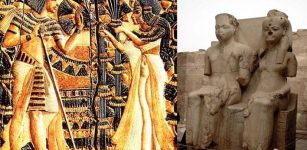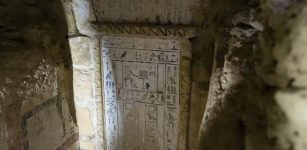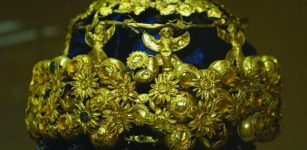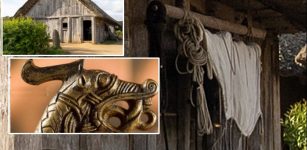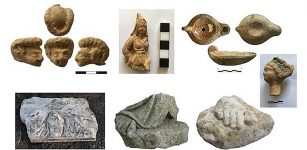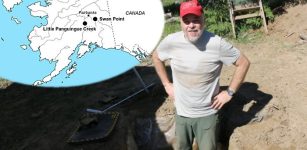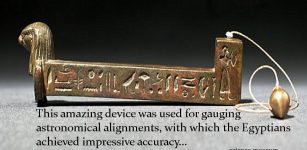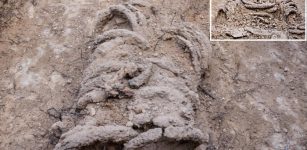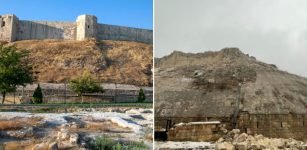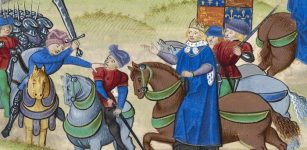Lost Viking Village Borgund And Its 45,000 Artifacts Hidden In A Basement Examined By Experts
Conny Waters - AncientPages.com - In 1953 while clearing the ground in Borgund on the west coast of Norway strange debris was discovered. Archaeologists came to the site and started excavating. They managed to identify 45,000 objects from the Middle Ages, but this fascinating discovery was quickly forgotten. The ancient items were stored in a basement, and nothing happened for 70 years.
This picture shows the excavation in 1954. The Borgund fjord can be seen in the background. The site was excavated also in the 1960s and 1970s, as well as smaller excavations more recently. In total there have been 31 archaeological field seasons at Borgund, the archaeologists write on their project page. Credit:Asbjørn Herteig/University Museum of Bergen
Now, scientists are examining the interesting artifacts and they shed light on the 1,000-year-old lost Viking village of Borgund.
There are a few written sources that mentions Medieval Borgund and describe it as one of the ‘small towns’ (smaa kapstader).
While speaking to Science in Norway, Professor Gitte Hansen, an archaeologist at the University Museum of Bergen revealed what scientists have learned about Borgund so far.
Professor Hansen explained Borgund was most likely built sometime during the Viking Age.
“The story of Borgund begins sometime in the 900s or 1000s.
Fast forward a few hundred years and this was the largest town along the coast of Norway between Trondheim and Bergen.
Activity in Borgund may have been at its most extensive in the 13th century.
In 1349, the Black Death comes to Norway. Then the climate gets colder.
Towards the end of the 14th century, the town of Borgund slowly disappeared from history.
In the end, it disappeared completely and was forgotten,” Science in Norway reports.
After having received financial support from the Research Council of Norway and contributions from several other Norwegian research institutions, Professor Hansen is now investigating the artifacts together with researchers in Germany, Finland, Iceland, and the USA.
A team has been put together comprising everything from textile researchers to experts in the Old Norse language.
By examining textiles found in Borgund scientists can learn what clothes people wore during the Viking Age.
What is this? A bag no one has opened before contains something the researchers currently have no idea what it is. A note written in the 1960s may provide some insight. Credit: Gitte Hansen
During the excavations of the lost Viking Borgund village, an archaeology team led by Asbjørn Herteig found precious items such as shoe soles, pieces of cloth, slag (the by-product of smelting ores and used metals), and potsherds that according to Professor Hansen can tell much about daily Viking life.
Many of the Viking items are still well-preserved and can be examined thoroughly. There are as many as 250 textile pieces in the basement.
“A Borgund garment from the Viking Age can be made up of as many as eight different textiles,” Professor Hansen explained.
According to Science in Norway, “in the remains of Borgund down in the basement under the museum in Bergen, researchers are now discovering ceramics from almost all of Europe.
“We see a lot of English, German and French tableware,” Hansen says.
People who lived in Borgund may have been in Lübeck, Paris, and London. From here they may have brought back art, music, and perhaps inspiration for costumes.
The town of Borgund was probably at its richest in the 13th century.
“Pots and tableware made of ceramic and soapstone from Borgund are such exciting finds that we have a research fellow in the process of specializing only in this,” Hansen says. “We hope to learn something about eating habits and dining etiquette here on the outskirts of Europe by looking at how people made and served food and drink.”
The study of the Borgund artifacts have already produced results and Professor Hanse says “there are many indications that people here had direct or indirect contact with people across large parts of Europe.”
Scientists have also discovered people in the Viking village Borgund enjoyed fish.
Fishing was important to the inhabitants of Borgund. However, it is still unclear whether they traded fish with other parts of Norway and Europe, or fi they perhaps delivered fish to the German Hanseatic League in Bergen.
Scientists found “a lot of fishing gear. This suggests that people in Borgund themselves may have fished a lot. A rich cod fishery in the Borgundfjord may have been very important for them,” Hansen says.
The remains from ironwork tells us that the forgotten town in Western Norway had several legs to stand on.
Maybe this was a town where blacksmiths had a particularly important role?
This could be part of a cloth collar someone wore around their neck. Or was it part of a coat that kept the boat crew in the Viking ships dry, a garment we know was almost a kind of 'Viking Age life insurance'? Under the ground in Borgund there were lots of clothing remains. The oldest may be more than a thousand years old. Swamplike soil has created good conservation conditions. Credit: Bård Amundsen/sciencenorway.no
And why in the world did Asbjørn Herteig and his colleagues find lots of shoemakers’ waste materials? As many as 340 shoe remains can tell us about both shoe fashion and what kind of leather people preferred for their shoes in the Viking Age.
From the historians' written sources, we know surprisingly little about Borgund.
That is why archaeologists and other researchers are so important in this particular project.
But one important historical source does exist.
It is a royal decree from 1384 which obliges the farmers of Sunnmøre to buy their goods in the market town of Borgund (kaupstaden Borgund).
“This is how we know that Borgund was considered a town at the time,” Hansen says. “This order can also be interpreted as Borgund struggling to keep going as a trading place in the years after the Black Death in the middle of the 14th century.”
It did not take long before the Viking village Borgund was forgotten.
Written by Conny Waters - AncientPages.com Staff Writer




